Letters to Doctor James Carmichael & Son
Historical Collections at the Claude Moore Health Sciences Library, University of Virginia
IMPORTANT: Please upgrade your browser to view this site as intended.
Site Navigation
Path to Current Page
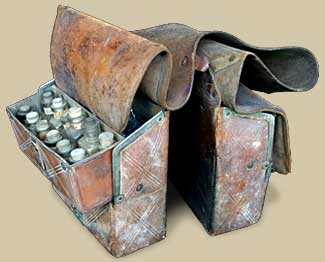
- Saddlebag (c. 1800s). The saddlebag was a necessary feature of a nineteenth-century medical practice. The Carmichaels’ patients frequently sent urgent letters requesting a doctor to “ride out” immediately to tend to an ill family member or slave.
Dr. James Carmichael began his medical practice in Fredericksburg in the 1790s and continued practicing with his sons up to the 1830s.
Medicine at that time was still quite primitive at best. Many medical inventions and discoveries that revolutionized medicine occurred in the latter half of the nineteenth century, well after the period that James Carmichael practiced. The Carmichaels did not have stethoscopes, thermometers, blood pressure equipment, or other diagnostic tools that we now consider fundamental. Scientific ideas such as the germ theory, antisepsis, and antiseptics were still not a part of medical knowledge or practice.

- Medicine Chest (c. 1850) and Pocket Pill Case (c. 1820).
The Carmichaels’ medical foundation rested on the Greek theory that the body consisted of four bodily humors: blood, phlegm, yellow bile, and black bile. Disease was caused by an imbalance of these humors. Hence, a physician’s duty was to employ treatment that would restore this delicate balance. Treatment, then, rested on curing the symptoms of the disease rather than the disease itself. Prescribed therapies were limited to diet, exercise, rest, bath, and “heroic medicine.” Heroic medicine, consisting of purging, starving, vomiting, or bloodletting, was thought to relieve the body of symptoms like fever or inflammation.
Bloodletting
Bloodletting, or bleeding, was an accepted practice from the time of the Greek physician Galen [130–200 AD] through the middle of the nineteenth century. In the Carmichael letters, bloodletting was used to treat toothaches, fevers, headaches, pain, mental illness, coughs, and colds. In essence, bloodletting was a remedy for almost every complaint.
The theory behind bloodletting was that disease caused blood to stagnate in certain parts of the body and that it needed to be released in order to revitalize the patient. Blood was drawn from the diseased area by applying leeches, cutting open a vessel, or using suction cups to form blood blisters. Typically, 16-30 ounces of blood were drained from a patient and caught in a shallow bowl. Treatment was stopped when a patient felt faint.
As a result of failed bleedings, purges, and other manipulations to cure disease, large segments of the population considered doctors useless or harmful. However, as evidenced in the letters of the Collection, the Carmichaels’ patients not only asked that the Carmichaels bleed them, but many knew how to bleed themselves as a treatment for illness.
- Cupping Glass and Tow c. 1820.
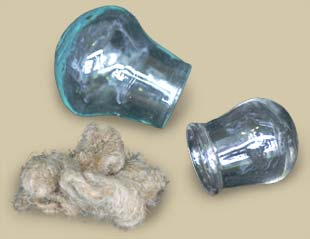
- Cupping was an ancient form of treatment used to draw blood to the surface of the skin. A pinch of tow, or lint, was ignited and placed in the cup. The cup was then applied to the patient’s skin. When the cup was placed on the patient’s skin, a vacuum was produced by the burning tow’s consumption of oxygen. When it cooled and the air inside contracted, a partial vacuum resulted, causing the skin to be sucked into the vessel and producing a rounded area of inflammation. Believers in this treatment thought the inflammatory response was therapeutic.
- Lancet c. 1850.

- Families frequently owned lancets to bleed their ill family members. In one Carmichael letter, William Herndon requests a new lancet be sent for his was “too dull for any purpose.” There is also evidence in the Carmichael letters that individuals refused to subject themselves to the lancet. Mr. Minor complained in a letter, “no entreaties would suffice for her [Mrs. Minor] to suffer the lancet.”
- Spring Lancet c. 1850.
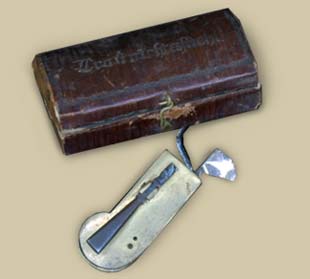
- The automatic or spring lancet, developed in Germany, permitted the operator to cut into the vein without exerting manual pressure. The blade snapped into the vein with the release of a spring. This instrument made the practice of bloodletting somewhat safer for non-physicians to perform. The spring lancet could penetrate a vein without cutting too deeply and causing serious bleeding.
- Octagonal Scarificator c. 1890.
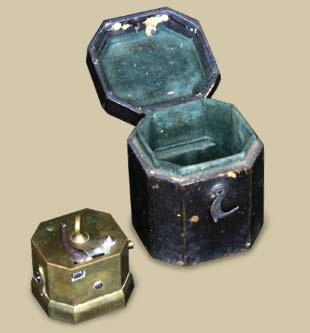
- The scarificator was designed in the early 1700s as a more merciful bloodletting device. At the flick of the release lever, multiple blades shot out to create an instantaneous series of parallel cuts. Raising and lowering the base with the knob on the top could adjust the cutting depth of the thirteen blades of this octagonal scarificator.
Trepanation
Practiced since prehistoric times, trepanation involved the removal of a piece of bone from the skull by scraping, grooving, cutting, or chiseling. Archaeological evidence indicates that some people survived the operation and even had it repeated. It was used to treat headaches, fractures, and mental disorders.
In a letter from W.O. Brown, Carmichael was summoned to perform trepanning on John Skinker who suffered a head injury after a fall from a horse. Brown explained that Skinker “received a Very Severe injoury on the head The Doctr. Thinks a fracture of the Skull – he lies in a State of Stupufaction – perhaps Trepaning Will be Necessary.”
- Trephine c. 1800s.

- The trephine is an instrument used to remove pieces of bone from the skull. This ebony, brass, and metal trephine has a round saw that bores a circular opening when the trephine is twisted. It was used after first incising the scalp over the skull and laying back a flap of skin.
Tooth Extraction
In the early part of the nineteenth century, prior to the establishment of dental schools, Virginians relied upon itinerant practitioners or the family doctor to take care of dental needs that they could not manage themselves. Because antibiotics were not available to treat infection, treatment generally meant tooth extraction. This was a complex and painful process because it was very important for the doctor not to break the tooth or allow any of the root to remain in the gum.
This Battaile letter, one of several written to the Carmichaels on the subject, highlights a patientís ambivalent wish for a tooth to be pulled:
Mrs. Battaile has been much afflicted with the toothache lately, & is now pregnant, she wishes you to come down & extract it for her, remembering the safety with which you extracted one for her some years ago – She is very timid, & her situation, perhaps, renders her more so at this time.
- Dental Tools c. 1800s
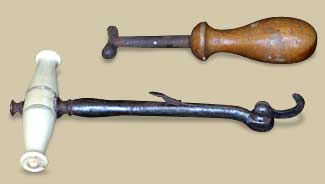
- The dental instrument on the top is a double elevator. It was used to apply hard pressure to the tooth. This forced the tooth against one of the sides of the socket causing the bone around the tooth to compress. After repeating this step many times, the socket became larger, loosening the tooth. The next step was to use the bottom instrument, a toothkey, so named because of its similarity to an eighteenth-century door key. The claw attached around the patientís tooth allowing for extraction.
Blister Plasters
Blister plasters were designed to act as a “counter irritant” to alleviate pain. The plaster, applied to the skin, caused a red spot or blister. The idea was that blood beneath the plaster and the whole “bulk of blood in the body” would set forth to the reddened area. The artificially created inflammation, it was theorized, would draw the blood away from the afflicted part of the body and hence cease any “pain and suffering.”
Manufacturers recommended leaving the plaster on the skin for up to twenty minutes and applying it one to three times a day. The directions for a mustard plaster, produced by Johnson & Johnson, warned that the red spot will “burn for some minutes” but recommended not putting anything on it unless the pain was “unbearable.”
- Mustard Plaster c. 1800s.
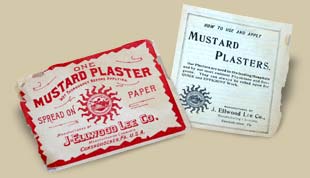
- The manufacturers of this mustard plaster claimed it was “invaluable” in relieving “inflammation” and “pain and suffering.” It was recommended for minor ailments such as diarrhea and sleeplessness and more serious cases such as pneumonia and paralysis.
- Camphorated Blister Plaster c. 1890.
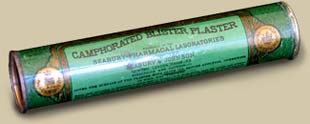
- The directions inform the user to “cover the surface of the plaster with olive oil before applying, otherwise it will not vesicate.”
Next: The Carmichaels and the Health Care of Slaves
© 2019, Rector and Visitors of the University of Virginia
Historical Collections and Services at the Claude Moore Health Sciences Library